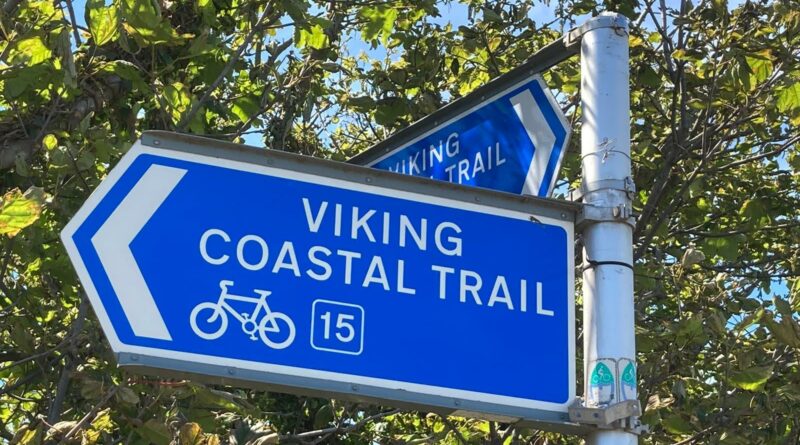Around the Isle of Thanet
Last summer with all our holiday plans cancelled, July saw a slight easing in the first Covid lockdown. So now or never, we decided to go for it with a 3 day mini tour. This is the story of the first day’s adventure into historic Kent.
The story of England is here for all to see. From invasions by Roman legions, Saxons and Vikings to the evacuation from Dunkirk and the D-Day landings. And not forgetting centuries of smugglers outwitting the King’s revenue men!
So eight of us set off with bikes on cars to start our ride from a free car park near Herne Bay. This being very conveniently, only 100 yds from this enticing sign!
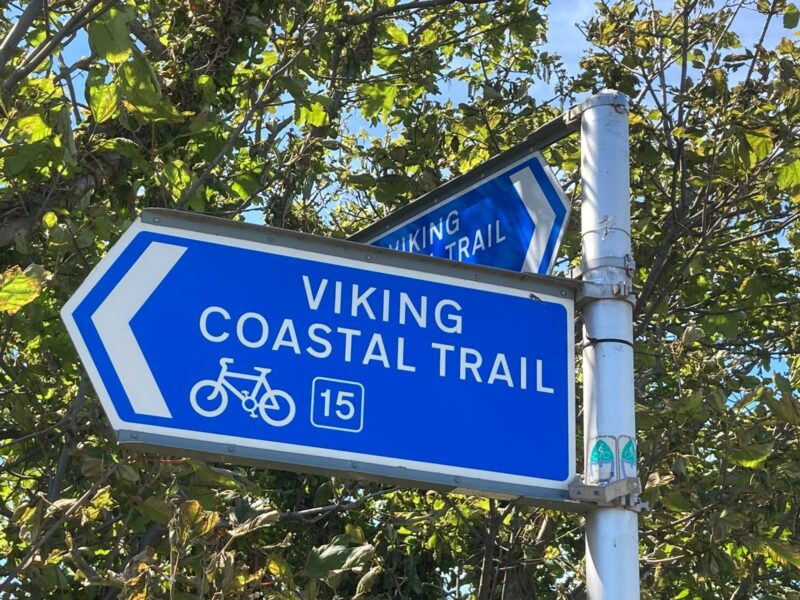
Upon arrival we soon had all the bikes unshipped and set off along the sea walls and promenades. These provided a good surface to cycle on for most of the way to Ramsgate, after which it was nearly all along country lanes back to Herne Bay.
So here we all are, on the sea front at the start of our ride. 7 of us, left to right – Jo Rifaat, me, Tom Moody, Jo Smith, Asif, Tom Vaz, Sue Smith, plus Denise at number 8 who was taking the photo. And note the blue sky! No wonder we are all smiling.

The main part of our day’s ride was a circuit, commencing and ending at Reculver, some 5 miles east of Herne Bay. This would take us all the the way around the Isle of Thanet.
When the Romans built their fort at Reculver, it really was an island, separated from the mainland of Kent by the Wantsum Channel. However over the past 2000 years, storms and coastal erosion have silted up the northern end of the channel, and what was in Roman times a 600 yard wide river is now just a narrow drainage ditch. The south eastern end of the channel is now the much reduced River Stour which flows into Pegwell Bay, south of Ramsgate.
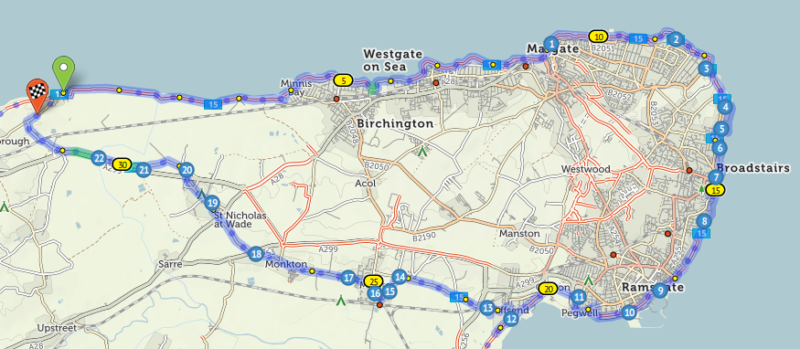
I have created the above map to show the route. To see the original, fully navigable route which is fully navigable, and has options to download as a GPX file for use on Garmin, mobile phones etc, or to see route directions (road names etc) and the terrain hill profiles click here ttps://cycle.travel/map/journey/151637
Five miles from Herne Bay, following the sea wall and a short bit of a cliff top, grassy track, we could see the Reculver Towers balancing on the edge of a slope into the sea.

Arriving at the Reculver Visitor Centre we found a very welcoming tea room – and regardless of Covid 19, it was open! So after our early morning start from Purley, we really enjoyed a cuppa.
Then it was off again, up a tarmac path to the Reculver Towers. Display boards outline the long history of what was originally an extensive Roman fort complex, one mile inland from the sea. Now little remains except these towers, the rest of the extended settlement having been consumed by erosion from storm whipped seas.
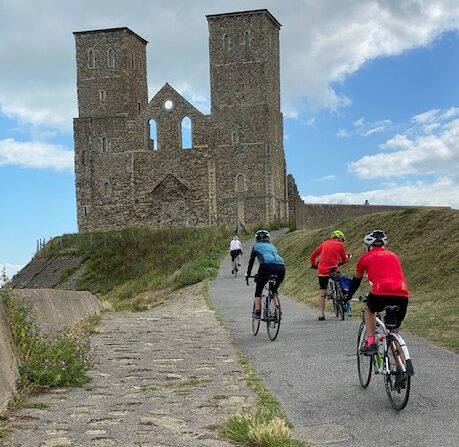
However the towers are not actually Roman. After 400 years as conquerors, the Romans were themselves pressured into leaving due to growing incursions and settlement by Germanic Angles and Saxons. They of course became the next major power in England, and some 200 year later the Saxon ruler of what is now Kent, was converted to Christianity by St Augustine. This Saxon warrior, no doubt to save his soul and gain entry into the Christian heaven, decided to have an abbey built. Re-cycling is nothing new. The Roman fort was knocked down and the stone used to build the abbey, whose towers you now see. However, like Canute, the ruler could not stop the ever encroaching sea. The abbey church eventually came under threat, so it too was part demolished and the stone used to build a new parish church further inland and still stands in today’s hamlet of Reculver.
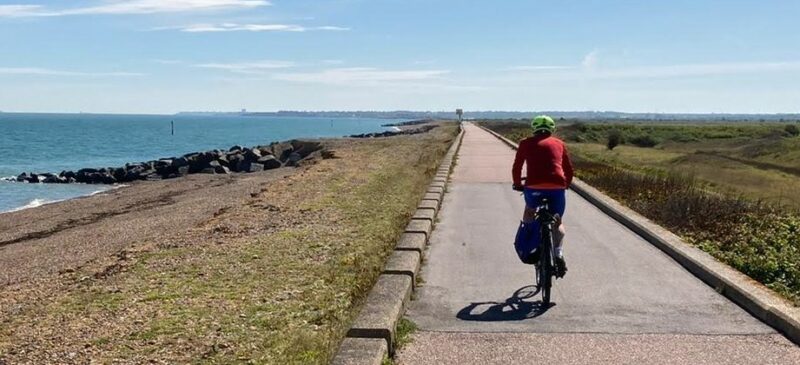
Leaving Reculver, the concrete seawall built to stop further coastal erosion, provides a flat and smooth ride stretching away into the distance. On the right is the extensive area of a wetlands national park for those interested in ornithology. After this the landscape changes, with chalk cliffs rising up from the sea, interspersed with sandy bays. In recent times these have become meccas for holiday makers and an ever extending urban sprawl. However our cycle route continued along their concrete promenades Our progress was now slowed by walkers, children, dogs and casual cyclists. So to speed things up, let me fast forward to Margate, the most popular of Thanet’s seaside resorts.
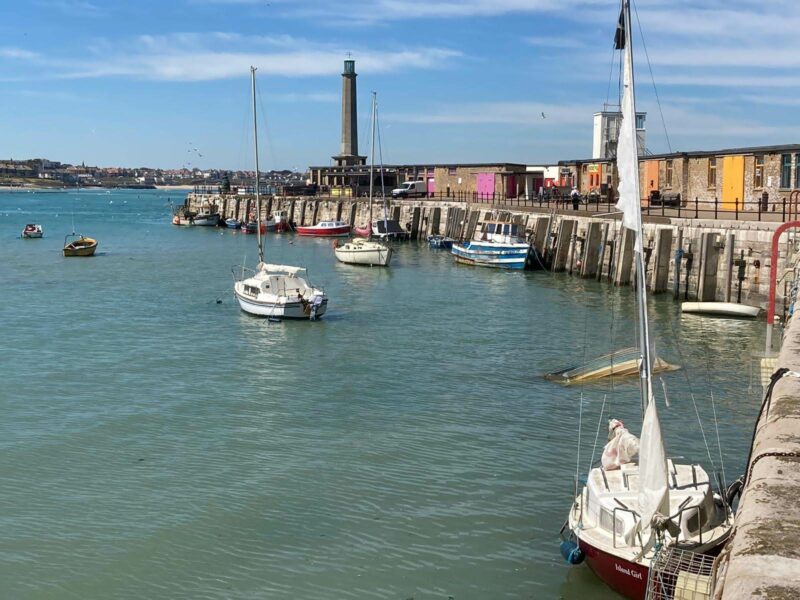
Once a working harbour, one of it’s regular cargoes was coal from Newcastle. But did you know that there were coal mines in Kent? The first mine in 1896, was at Dover, tunnelling out under the sea. And there were several more deep mines in this part of Kent until the 1980s when they were closed down. So instead of coals from Newcastle being brought to Margate, the colliers were sailing out from Margate with Kentish coal!
But other valuable cargoes were occasionally brought into Margate. For example, in 1967 a large motor boat arrived here with much sought after King Edward cigars. Unfortunately for the boat and it’s crew, they had been shadowed from Nieuport in Belgium by a U.K Customs cutter. Upon entering Margate harbour, the boat was boarded, the boat and cargo seized and the smugglers arrested. Just like old times!
Leaving the harbour, our route took us up and along the cliff top road towards the first of 7 secluded bays of golden sand. This one, Botany Bay, is famous for it’s chalk stacks and caves carved out by stormy seas. And not of course forgetting it’s history of smuggling!
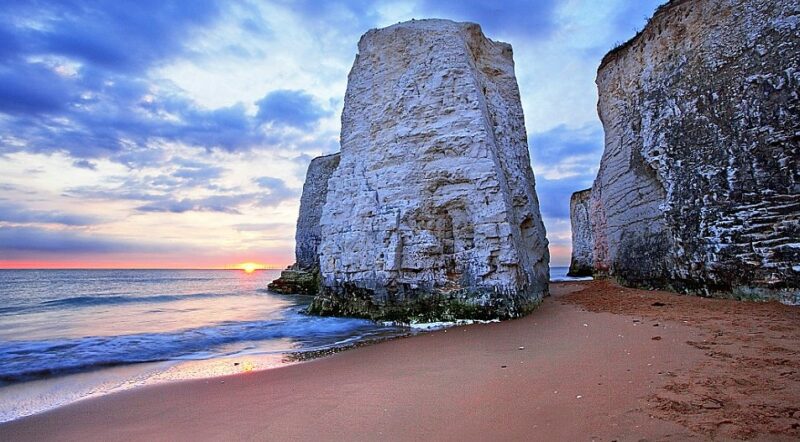
Smuggling was a local industry in this area, being a very profitable business due to the high Customs duties on tea, spirits and tobacco. The smugglers used the network of tunnels and caves in the chalk cliffs to hide the contraband. The most famous local smuggler was Joss Snelling. So famous was he, that another of the 7 bays is named Joss Bay after him. Botany Bay is a memory of those days. It was here that the Customs men caught Joss and his gang. A bloody battle took place with fists, cutlasses and boat hooks. Joss escaped but lost 15 of his men. The punishment for smuggling and resisting arrest was transhipment to Australia’s convict settlement at Botany Bay. Hence the naming of this bay after the local men who ended their days in Oz
But this was not the end of smuggler Joss. Some years later, in 1830 at the age of 91, he was caught by Customs men at Minnis Bay when landing 61 barrels of foreign spirits. Due to his age he got away with just a hefty fine. But so great was his local notoriety, that on a visit to Broadstairs by the young Queen Victoria, he was introduced to her as Joss “the famous smuggler” !

Next comes Kingsgate Bay which also has a connection between Royalty and villainy.
King Charles II, enroute by sea from London to the cross channel port of Ramsgate, was forced to land here during a violent storm. To mark this life saving escape from drowning he named the bay as the Kings Gate(way). The mock castle that now adorns it’s headland was financed by grand theft by Henry Fox, or to give him his title, Lord Holland, of whom you probably know nothing. However you will have heard of Holland Park in west London, a suburb where Henry Fox had a grand park and grand mansion. But desirous of having a seaside “cottage” he built Kingsgate Castle!
Fox by name and sly fox by nature, his position as the King’s Paymaster General allowed an estimated £50 million (at year 1760 values) to disappear into his back pocket and reappear as his grandiose mansions!
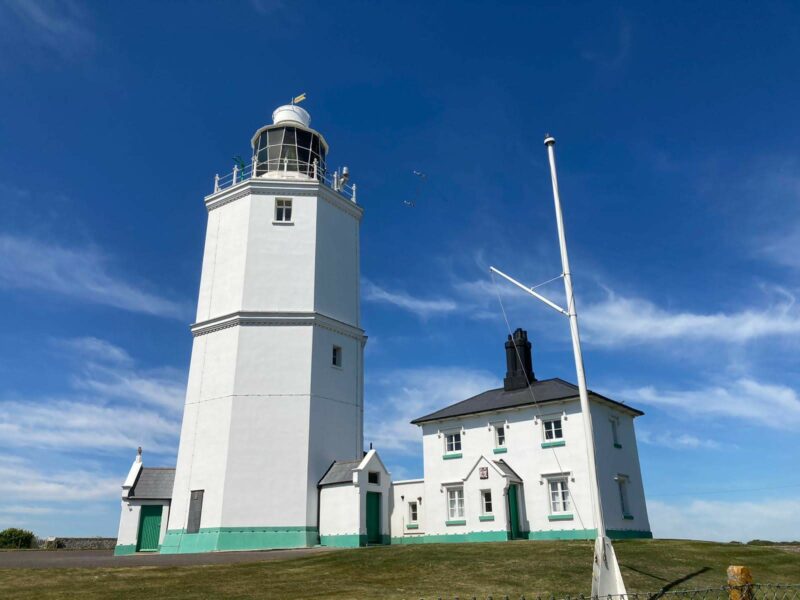
Continuing along the cliff top road we soon came to the North Foreland Light House. This guides ships into the Thames Estuary, or heading in the opposite direction, warms ships that they are approaching the dangerous Goodwin Sands. It is estimated that over 2,000 ships have met a watery grave here, the skeleton’s of which often rise up from the sands following stormy weather.
In 1824 the Harbour Master from Ramsgate organised a cricket match on the Goodwins during a summer neap tide when the sands appear above sea level. An annual match was then held until 2003. In 2006 the BBC organised a re-creation of those historic matches for a documentary. Unfortunately due to inexperience of these tidal waters, they had to be rescued by the Ramsgate life boat!
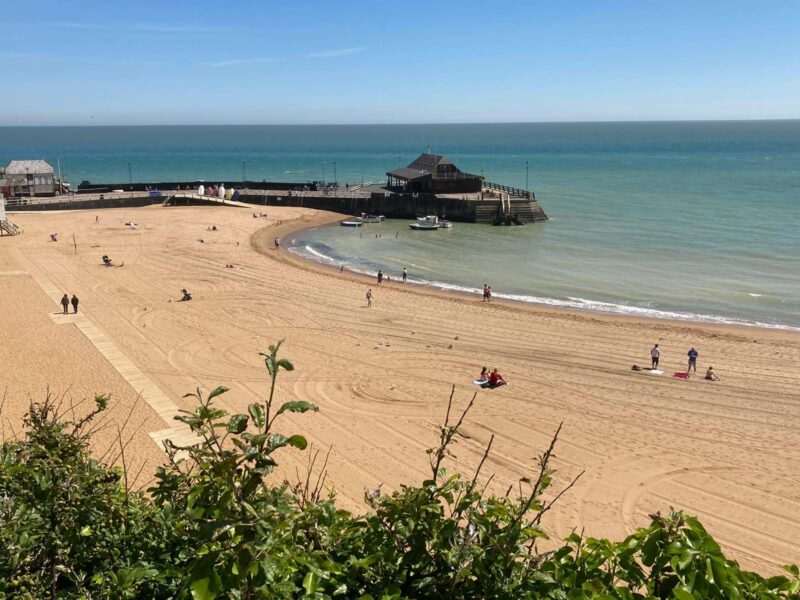
A mile or so further on we arrived at the lovely resort of Broadstairs with it’s wide sandy bay and old Victorian charm. And I don’t need to tell you who lived below. The most famous of Broadstair’s residents!

Our next stop and a time for our lunch break, was the only port in England to have been honoured with the title of “Royal”, given by King George IV in 1821. So here is our regal Jo at the Royal Harbour of Ramsgate.

Ramsgate has seen so much of our nations wars, going back to at least Roman times. More recently it was recorded during the Napoleonic Wars that “The Household Cavalry and Royal Dragoons marched 6-abreast to embark on 34 vessels, heading for Ostend in the Spring of 1815. From there they continued on, to join Wellington and fight at the Battle of Waterloo”
But today Ramsgate is remembered for the pivotal role of the armada of 4,200 “little ships” during the Dunkirk Evacuation in 1940, when close to 350,000 British and Allied troops were saved from death or capture..
Little known, but another act of wartime heroism is this memorial beside the harbour. It relates how the crew of 6 aircraft took off from Ramsgate to attack a heavily armed German battle fleet in the Dover Straits. All 6 planes were shot to pieces. Of the 18 airmen, only 5 survived to be rescued from the cold waters of the English Channel.
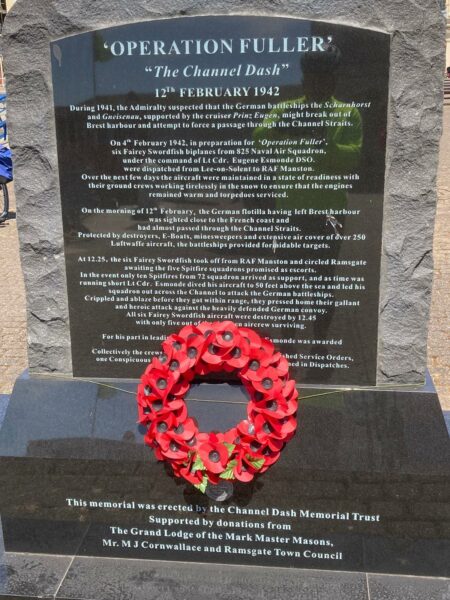
Our last stop on our coastal journey was at Pegwell Bay. It was here in 54 B.C that Julius Caesar beached his fleet of ships and landed his legions and cavalry. He is claimed to have said “Veni, vidi, vici!” – I came, I saw, I conquered! Not strictly true. He and his army only paid a short visit, it was another 80 years before the conquering bit was done by the legions of Claudius. This landing was where the River Stour enters Pegwell Bay, which in Roman times was the eastern end of the Wantsum Channel. Here a Roman fort was built, which over time became a port and Roman town. Today it is known as Richborough and what little remains, looks like this:
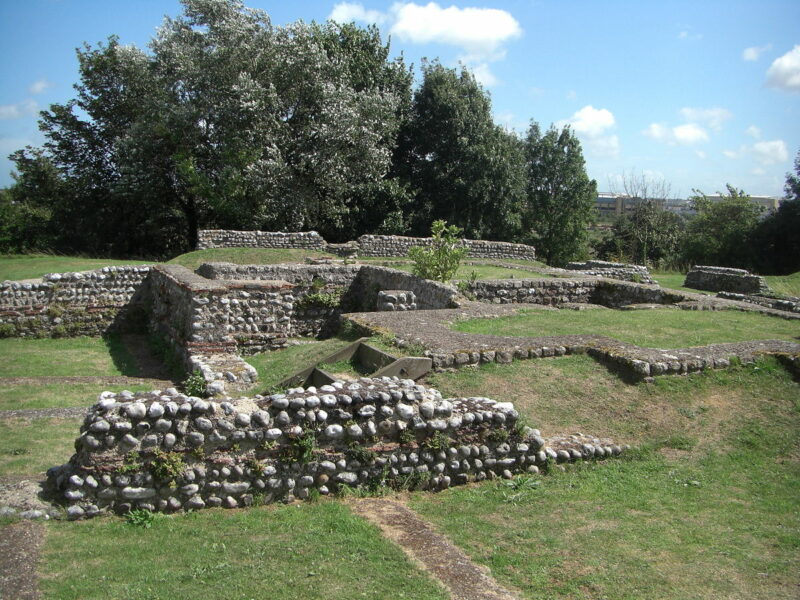
But back to Pegwell Bay. In 1949 a true replica of a Viking ship was built in Denmark. It was then rowed and sailed across the North Sea to recreate a real life voyage by Vikings who had landed some 1,000+ years earlier at Pegwell Bay. However without the aid of Satnav or Garmin they ended up in one of the bays at Broadstairs, which ever since has been known as “Viking Bay”.
The good old English newspaper, the Daily Mail, came to the rescue by acquiring this Viking ship and having it displayed at it’s intended location at Pegwell Bay.
As you can see, it would have needed a lot more than us seven to row this sizeable ship!
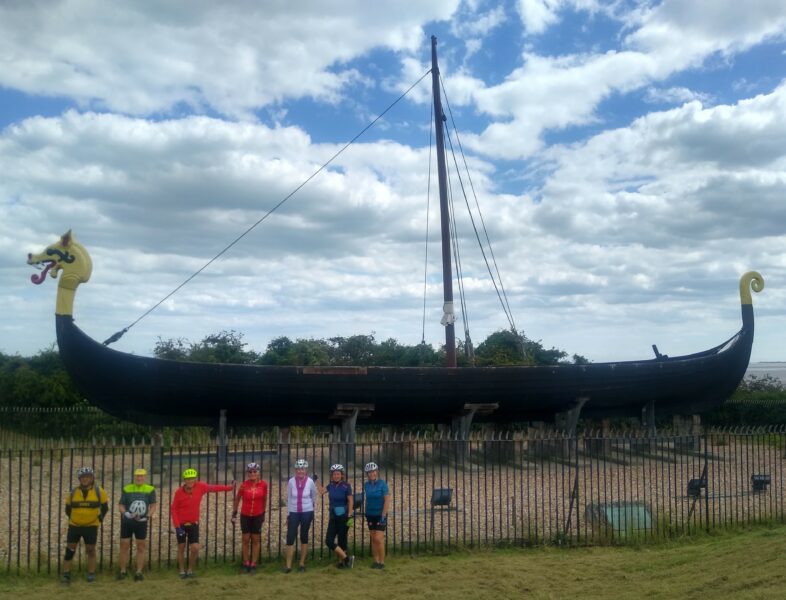
From here we started our return journey via country lanes and a few ancient Kent hamlets and villages. A mile or so later we passed St Augustine’s Cross. It was here that in 597AD St Augustine was claimed to have said a Mass with his 30 companions, in thanksgiving at his safe arrival in England. I thought that this was a genuine ancient cross but the plaque showed that it was a Victorian creation!
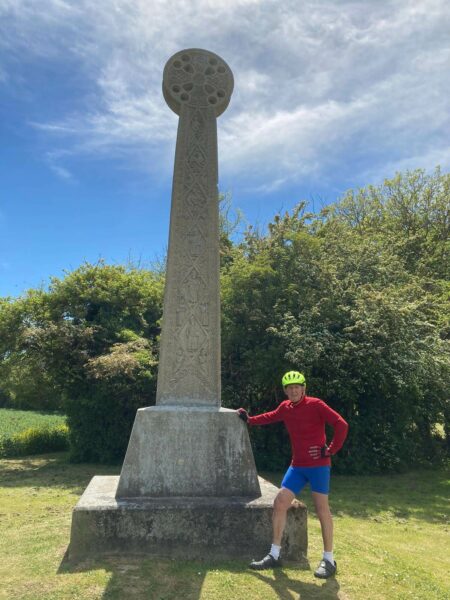
Continuing down old memory lanes we passed historic Minster Abbey, several old flint built village churches, an old cottage where the roof was being re-thatched, and an old windmill
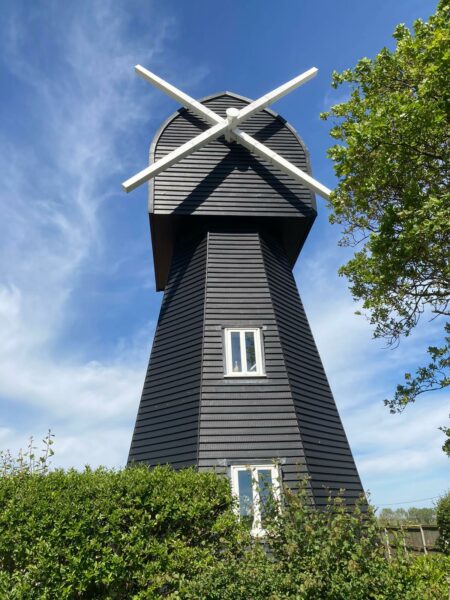
At the little village of St Nicholas at Wade, we learnt that it was so named because in earlier days there was a ford where people could wade across the River Wantsum. Whilst the church of St Nicolas still stands the Wantsum River in now only a 2 foot wide ditch, so wading is no longer required!
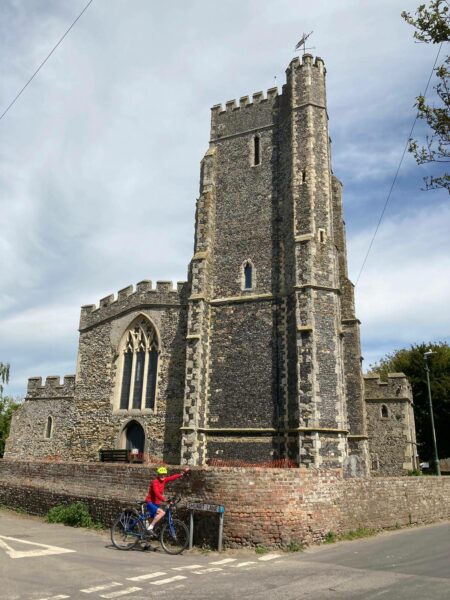
We stopped for a final cup of tea at the Reculver Visitor centre and then had to battle a stiff sea breeze the last 5 miles back to Herne Bay. We started our ride here with a photo taken by Denise, so I will end with another taken by her.

This was day one of our Kent Tour. Five of us then travelled on to Dover for days 2 and 3, so more to follow!
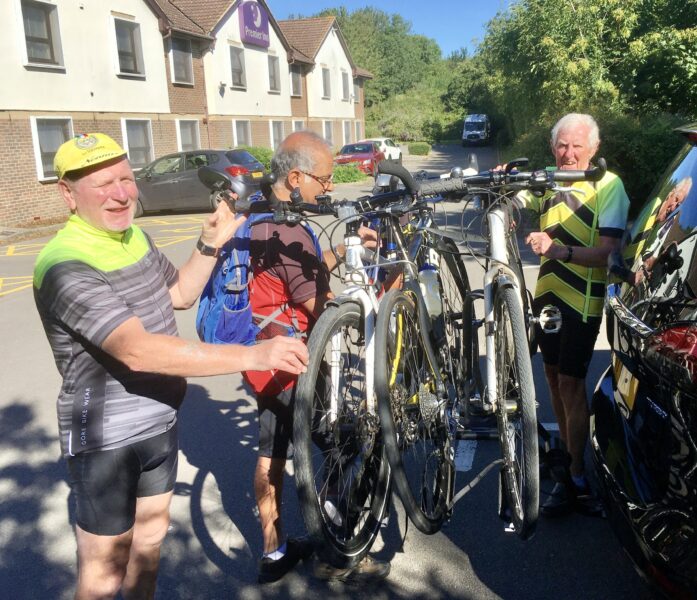
The next day started with us exploring the world famous white cliffs of Dover and much more! So start here https://anerleybc.org/a-white-cliffs-bike-ride/
Des.

